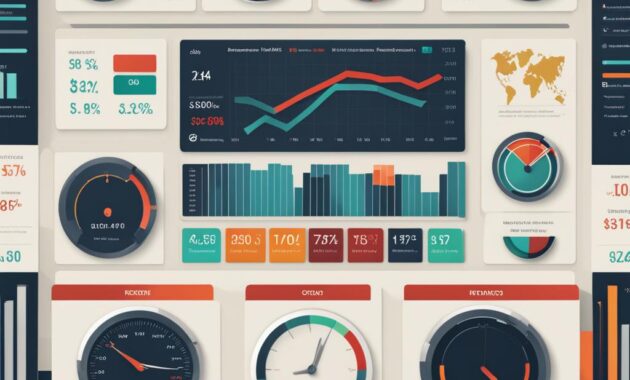Welcome to our comprehensive guide on economic indicators, the essential metrics that provide valuable insights into the state of the economy and the financial markets. In this section, we will explore the importance of economic indicators and their impact on investment strategies. By understanding how to interpret these numbers, we can make informed decisions that take into account the current economic climate.
Economic indicators are statistical data points that provide information about different aspects of the economy, such as employment, inflation, and consumer spending. These numbers are essential for investors and analysts because they offer insights into economic trends and can guide investment decisions. For example, if the unemployment rate is high, it may indicate a weaker economy, which could affect the performance of certain sectors or industries.
The financial markets are inextricably linked to economic indicators, as they reflect the overall health of the economy. By monitoring these metrics, investors can adjust their strategies accordingly and take advantage of emerging opportunities.
Investment strategies rely heavily on economic indicators, as they provide valuable information that can influence decision-making. Understanding how to interpret these numbers is crucial for developing effective strategies that align with the current economic climate.
In the following sections, we will provide a detailed overview of economic indicators and their role in the economy, highlight key indicators to watch, and offer insights into how to use this information to develop successful investment strategies.
Understanding Economic Indicators and Their Role in the Economy
As we’ve mentioned, economic indicators are essential for understanding the state of the economy and making informed investment decisions. But what exactly are economic indicators, and how do they fit into the larger picture of the economy?
Simply put, economic indicators are data points that provide information on the performance of various aspects of the economy. These data points can come from a variety of sources, including government agencies, research firms, and financial institutions. Investors and analysts use these data points to track trends, make forecasts, and identify opportunities for investment.
There are three main types of economic indicators: leading, lagging, and coincident indicators. Leading indicators are data points that tend to change before the economy as a whole changes. They’re used to anticipate future trends in the economy. Lagging indicators, on the other hand, change after the economy has already started to shift. They’re used to confirm trends that have already taken place. Coincident indicators are data points that change at the same time as the economy as a whole. They’re used to provide a real-time snapshot of the economy.
So, what is the role of economic indicators in the overall economy? Put simply, economic indicators provide a barometer for the health of the economy. They help us understand how different sectors and industries are performing, which can help us make more informed decisions about where to invest our money. By keeping a close eye on economic indicators, we can gain a better understanding of where the economy is heading and adjust our investment strategies accordingly.
“Economic indicators provide a barometer for the health of the economy.”
The importance of economic indicators for policymakers
While economic indicators are crucial for investors and analysts, they’re also essential for policymakers. Government agencies and central banks use economic indicators to monitor the health of the economy and make decisions about monetary policy. For example, the Federal Reserve may use indicators such as inflation and unemployment rates to adjust interest rates. By using economic indicators to guide policy decisions, policymakers can help promote economic stability and growth.
The limitations of economic indicators
It’s important to note that economic indicators have their limitations. For one thing, economic data can be subject to revision, which can make it difficult to make accurate predictions about future trends. Additionally, economic data can be influenced by a variety of factors, including unexpected events such as natural disasters or geopolitical conflicts. It’s also important to keep in mind that economic indicators are just one part of the larger picture of the economy. Other factors, such as consumer sentiment and geopolitical risks, can also have a significant impact on economic trends.
Despite these limitations, economic indicators remain an essential tool for understanding the state of the economy. By keeping a close eye on these data points and understanding their role in the larger economy, we can make more informed decisions about our investments and financial planning.
Key Economic Indicators to Watch
As we mentioned earlier, economic indicators provide valuable insights into the overall health of the economy. There are numerous economic indicators that investors and analysts monitor, but some are more critical than others. Let’s take a look at some of the key economic indicators to watch:
| Economic Indicator | What it Measures | Why it Matters |
|---|---|---|
| Gross Domestic Product (GDP) | The total value of goods and services produced in a country during a specific time period | GDP is a broad measure of economic activity and is often used as an indicator of economic growth. It provides a snapshot of the overall health of the economy. |
| Inflation Rate | The rate at which prices for goods and services are increasing over time | High inflation can erode purchasing power and reduce the value of investments. Understanding inflation trends is critical for making informed investment decisions. |
| Unemployment Rate | The percentage of the labor force that is currently unemployed | High unemployment can indicate a weak economy, while low unemployment can signal a strong economy with a tight job market. Understanding employment trends can help investors identify potential opportunities and risks. |
| Consumer Price Index (CPI) | A measure of the average change in prices over time for goods and services consumed by households | CPI is used to track inflation and can provide insights into how much consumers are spending. As consumer spending is a key driver of economic growth, understanding CPI trends is essential for developing effective investment strategies. |
| Industrial Production Index (IPI) | A measure of the output of the industrial sector of the economy | Changes in the IPI can provide insights into broader economic trends. As the industrial sector is a critical component of many economies, understanding IPI trends is essential for developing effective investment strategies. |
It’s important to note that economic indicators do not exist in a vacuum. They are interconnected, and changes in one indicator often impact others. For example, changes in the unemployment rate can impact consumer spending, which in turn can impact GDP growth. By monitoring and analyzing multiple economic indicators, investors can gain a more comprehensive understanding of the state of the economy.

Interpreting Economic Indicators for Investment Strategies
As we’ve seen in the previous sections, economic indicators provide valuable insights into the health of the economy. However, what really matters for investors is how to use this information to make informed investment decisions. In this section, we’ll explore how to interpret economic indicators to develop effective investment strategies.
First and foremost, it’s important to understand that different economic indicators can provide insights into specific sectors or industries. For example, if you’re interested in investing in the housing market, you would likely pay close attention to indicators such as housing starts, building permits, and home sales. On the other hand, if you’re looking to invest in the technology sector, you might focus on indicators such as productivity, capital expenditures, and consumer spending on electronics.
It’s also important to recognize that some economic indicators are more leading than others. Leading indicators provide a glimpse into the future state of the economy, while lagging indicators confirm trends that have already taken place. For example, the Consumer Price Index (CPI) is a lagging indicator that measures the cost of living, while the Purchasing Managers’ Index (PMI) is a leading indicator that measures the health of the manufacturing sector.
As investors, we need to pay attention to both leading and lagging indicators to develop a well-rounded view of the economy and potential investment opportunities. By doing so, we can identify trends and patterns that may not be immediately evident, and adjust our investment strategies accordingly.
One tool that can be useful in interpreting economic indicators is technical analysis. Technical analysis is the study of market activity, such as price movements and trading volumes, to identify potential buy and sell signals. By combining technical analysis with an understanding of economic indicators, investors can better time their entry and exit points in the market.
Example: Analyzing Unemployment Data with Technical Analysis
Let’s say we’re interested in investing in the retail sector. We know that consumer spending is a key economic indicator that impacts retail sales, so we decide to monitor the unemployment rate as a leading indicator of consumer confidence.
Using technical analysis, we can plot the unemployment rate on a chart and look for trends and patterns. For example, if we see a sharp drop in the unemployment rate, we might anticipate increased consumer spending and invest accordingly.
In this example, we see that the unemployment rate has been steadily declining since 2010. Using technical analysis, we might look for key support and resistance levels on the chart to identify potential buy and sell signals. For example, if the unemployment rate were to drop below a certain level, we might interpret that as a sign of strong consumer confidence and a potential buy signal for retail stocks.
Of course, this is just one example of how to interpret economic indicators using technical analysis. The key takeaway is that by combining different types of analysis, we can make more informed investment decisions and increase our chances of success.
Conclusion
In conclusion, we hope this deep dive into economic indicators has provided you with a better understanding of their significance in the financial markets and investment strategies. Monitoring key indicators such as GDP growth, inflation, unemployment rate, and consumer spending can give us valuable insights into the overall health of the economy and specific sectors or industries.
As investors and analysts, it is essential to stay updated on the latest economic data and interpret these numbers to make informed investment decisions. By doing so, we can navigate the financial markets with greater confidence and achieve our financial goals.
Remember, developing effective investment strategies involves more than just monitoring economic indicators. It also requires careful analysis of market trends, risk assessment, and portfolio diversification. However, understanding the relationship between economic indicators and investment opportunities is a crucial part of successful financial planning.
Thank you for joining us on this journey through economic indicators and their role in the financial markets. We hope it has been an informative and valuable experience. Stay tuned for more insights into the world of finance and investing.




